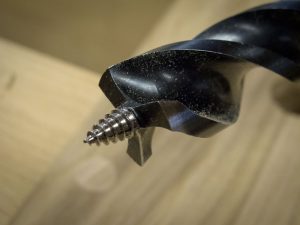We may receive a commission when you use our affiliate links. However, this does not impact our recommendations.
When building a workbench, boring the dog and holdfast holes is a drag, even with an electric drill. Last month, however, that all changed.
While building a French oak Roubo workbench at an event put on by Benchcrafted (details here and the movie is here), Jameel Abraham introduced me to Japanese-made WoodOwl Nail Chipper bits. These bits have three cutting lips and are very nicely made – better than high-quality vintage augers.
The result is that the bits are wicked fast and cut fairly cleanly, though you’ll still have some cleanup around the rim.
But it is worth is when you can power through oak that is 6” thick in seconds.
We used these bits to make the through-mortises in the 6”-thick benchtops, which are 18th-century French oak. The oak was still a little wet, but these bits just could not be stopped. And even after 10 benches or so, the bits were still sharp.
(Note that they are resharpenable and you can buy a file to do the job.)
I bought my bits from Traditional Woodworker and could not be more pleased. These bits are so good that they are going to change my curriculum for when we build workbenches in class.
— Christopher Schwarz
Want bucketloads of workbench information? Check out my first book, “Workbenches: From Design & Theory to Construction & Use” (Popular Woodworking).
Here are some supplies and tools we find essential in our everyday work around the shop. We may receive a commission from sales referred by our links; however, we have carefully selected these products for their usefulness and quality.










I must be doing something wrong. I bought one of these to use for drilling dog holes in my new bench; Bob Lang’s 20th century bench. The top is 3″ thick soft maple. Every time I try to drill a dog hole using my drill press it jams. No matter what speed I use as soon as the lead screw hits the wood it jerks the bit into the wood stalling the drill press.
This bit is every bit (intended) as good as Chris says. As for the Veritas bench dogs not fitting.. yeah, they’re a bit tight, but i think a little use and they’ll make it. I’m using it on my Robert Lang bench with a hard maple top(s).
If you plan on using this bit for bench dog holes to accommodate Veritas dogs / accessories, be sure to get the Imperial 3/4″. I purchased a 19mm (0.748 inch) Nail Chipper for this purpose, and was disappointed to discover that my Veritas bench dogs do not fit.
I should think you could start the hole with a slowly fed Forstner bit and end up with a clean hole.
Chris,
I am in the process of building Bob’s workbench out of Capirona – Amazon Maple which is much harder than Oak.
I have use a 3/4 bit I purchased from Germany to bore the holes in the front rail and the rear bench top. The bit is now in need of re-sharping–hard wood for sure. Do you think the Chipper bit would hold up longer than the one I have?
Still have the front top dog holes to go.
Randy
Lima, Peru
That drill is a hand tool, eh? A drill press would be a power tool, right? (Sorry, the devil made me do it and I couldn’t resist.)
That looks like an awesome wood auger! thanks for the tip.
Chris what drill are you using? Not sure if it`s the bit or drill, but that was amazingly fast on Oak, and didn`t look like a bad hole either.
One of your good ones 😉
Do you think these would work in a brace that can take a hex shank?
Looking at the different WoodOwl options, is there an advantage to the Nail Chipper over the (slightly more expensive but still oddly inexpensive) Ultra Smooth? Since I am not planning to drill through nail-ridden wood for my benchtop, can I expect that the Ultra Smooth might give a cleaner finish? Thanks for any advice…
The Traditional Woodworker lists these in imperial units but the WoodOwl website lists them in both imperial and metric units. Are they metric bits sold as imperial equivalent?
I really like most of the Japanese and European tools that I have purchased but I still work in imperial units and sometimes having both around really becomes a problem.